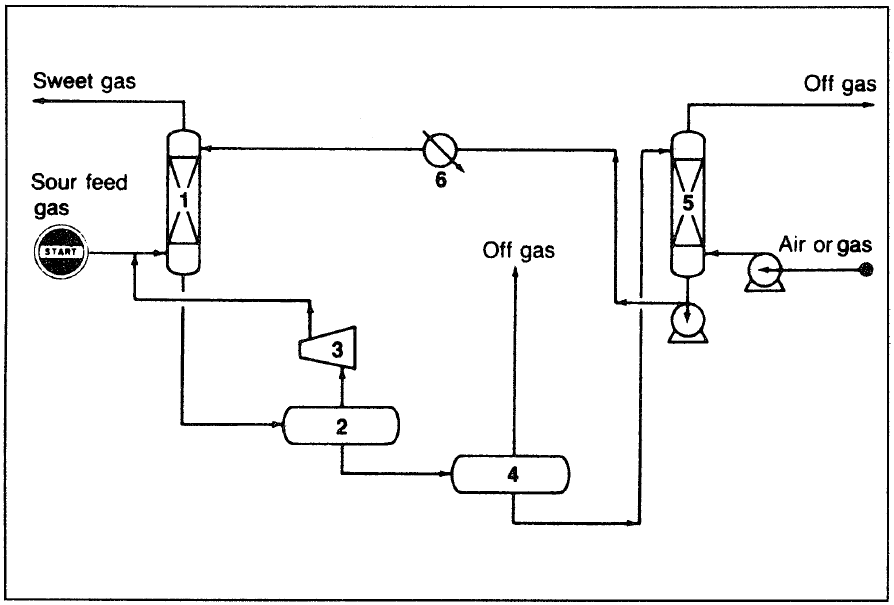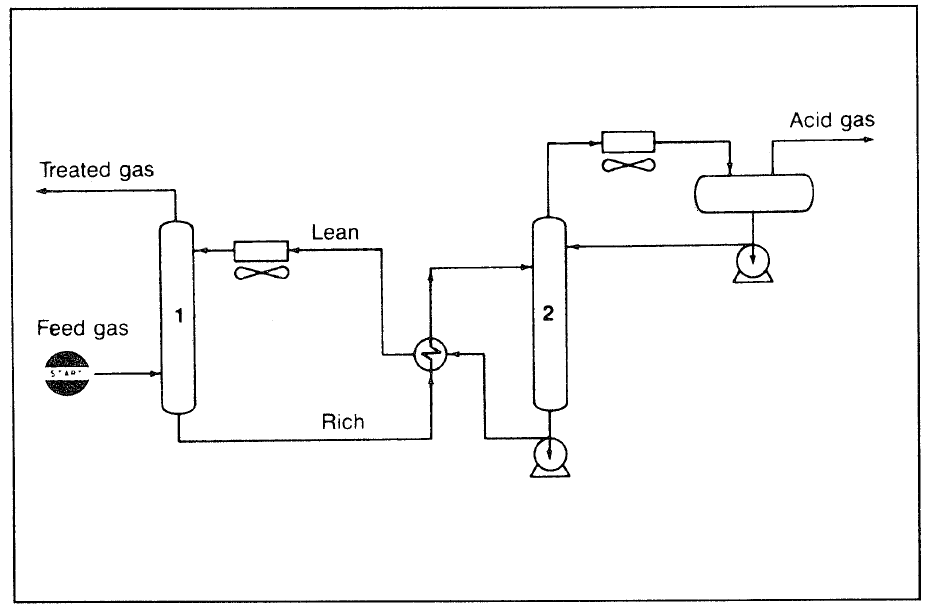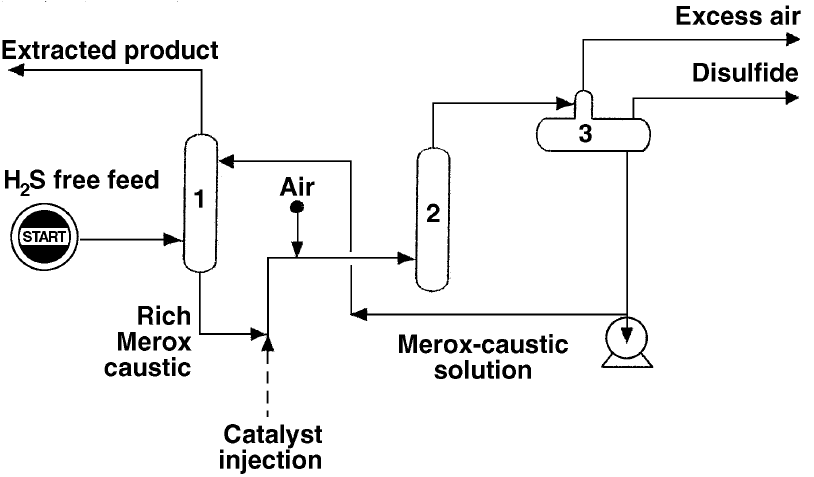
Acid Gas Treatment
 المؤلف:
sami matar & Lewis. F. Hatch
المؤلف:
sami matar & Lewis. F. Hatch
 المصدر:
Chemistry of PETROCHEMICAL PROCESSES
المصدر:
Chemistry of PETROCHEMICAL PROCESSES
 الجزء والصفحة:
2th p .3
الجزء والصفحة:
2th p .3
 23-11-2015
23-11-2015
 4287
4287
Acid Gas Treatment
Acid gases can be reduced or removed by one or more of the following methods:
1. Physical absorption using a selective absorption solvent.
2. Physical adsorption using a solid adsorbent.
3. Chemical absorption where a solvent (a chemical) capable of reacting
reversibly with the acid gases is used.
Physical Absorption
Important processes commercially used are the Selexol, the Sulfinol, and the Rectisol processes. In these processes, no chemical reaction occurs between the acid gas and the solvent. The solvent, or absorbent, is a liquid that selectively absorbs the acid gases and leaves out the hydrocarbons. In the Selexol process for example, the solvent is dimethyl ether of polyethylene glycol. Raw natural gas passes countercurrently to the descending solvent. When the solvent becomes saturated with the acid gases, the pressure is reduced, and hydrogen sulfide and carbon dioxide are desorbed. The solvent is then recycled to the absorption tower. Figure 1-1 shows the Selexol process.2

Figure. 1 The Selexol process for acid gas removal:2 (1) absorber, (2) flash drum, (3) compressor, (4) low-pressure drum, (5) stripper, (6) cooler.
Physical Adsorption
In these processes, a solid with a high surface area is used. Molecular sieves (zeolites) are widely used and are capable of adsorbing large amounts of gases. In practice, more than one adsorption bed is used for continuous operation. One bed is in use while the other is being regenerated.
Regeneration is accomplished by passing hot dry fuel gas through the bed. Molecular sieves are competitive only when the quantities of hydrogen sulfide and carbon disulfide are low. Molecular sieves are also capable of adsorbing water in addition to the acid gases.
Chemical Absorption (Chemisorption)
These processes are characterized by a high capability of absorbing large amounts of acid gases. They use a solution of a relatively weak base, such as monoethanolamine. The acid gas forms a weak bond with the base which can be regenerated easily. Mono- and diethanolamines are frequently used for this purpose. The amine concentration normally ranges between 15 and 30%. Natural gas is passed through the amine solution where sulfides, carbonates, and bicarbonates are formed. Diethanolamineis a favored absorbent due to its lower corrosion rate, smaller amine loss potential, fewer utility requirements, and minimal reclaiming needs.3 Diethanolamine also reacts reversibly with 75% of carbonyl sulfides (COS), while the mono- reacts irreversibly with 95% of the COS and forms a degradation product that must be disposed of. Diglycolamine (DGA), is another amine solvent used in the Econamine process (Fig 2).

Figure 2. The Econamine process: (1) absorption tower, (2) regeneration tower.
Absorption of acid gases occurs in an absorber containing an aqueous solution of DGA, and the heated rich solution (saturated with acid gases) is pumped to the regenerator. Diglycolamine solutions are characterized by low freezing points, which make them suitable for use in cold climates. Strong basic solutions are effective solvents for acid gases. However, these solutions are not normally used for treating large volumes of natural gas because the acid gases form stable salts, which are not easily regenerated. For example, carbon dioxide and hydrogen sulfide react with aqueous sodium hydroxide to yield sodium carbonate and sodium sulfide, respectively.

However, a strong caustic solution is used to remove mercaptans from gas and liquid streams. In the Merox Process, for example, a caustic solvent containing a catalyst such as cobalt, which is capable of converting mercaptans (RSH) to caustic insoluble disulfides (RSSR), is used for streams rich in mercaptans after removal of H2S. Air is used to oxidize the mercaptans to disulfides. The caustic solution is then recycled for regeneration. The Merox process (Fig.3) is mainly used for treatment of refinery gas streams.

Figure 3. The Merox process: (1) extractor, (2) oxidation reactor.
 الاكثر قراءة في البترو كيمياويات
الاكثر قراءة في البترو كيمياويات
 اخر الاخبار
اخر الاخبار
اخبار العتبة العباسية المقدسة


